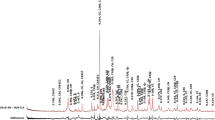Abstract
Recently, the use of crushed sand obtained from limestone-quarried is growing especially in the countries where river sand is not quite available. In the paper, the results from an experimental investigation are presented, which evaluates the pore structure of mortar mixtures where fine aggregate is replaced by Crushed Limestone Sand (CLS). The behavior of pore structure of CLS mortar was compared to that of mortars prepared from Nature River Sand (NRS). A Mercury Porosimeter Intrusion (MIP) is adopted to study the behavior of pore size distribution. Both CLS and NRS mortar with four water-cement ratios and five sand-cement ratios are used to determine pore structure. An analytical model was established to compare changes in pore structure for different water cement ratio and volume of sand, and the model was based on the test results.
Similar content being viewed by others
References
Aly, T. and Sanjayan, J. (2010). “Effect of pore-size distribution on shrinkage of concretes.” J. Mater. Civ. Eng., Vol. 22, No. 5, pp. 525–532.
Chen, X., Wu, S., and Zhou, J. (2013). “Influence of porosity on compressive and tensile strength of cement mortar.” Constr. Build. Mater., Vol. 40, No. 3, pp. 869–874.
Collins, F. and Sanjayan, J. G. (2000). “Effect of pore size distribution on drying shrinking of alkali-activated slag concrete.” Cem. Concr. Res., Vol. 30, No. 9, pp. 1401–1406.
Cook, R. A. and Hover, K. C. (1993). “Mercury porosimetry of cementbased materials and associated correction factors.” Constr. Build. Mater., Vol. 7, No. 4, pp. 231–240.
Cook, R. A. and Hover, K. C. (1999). “Mercury porosimetry of hardened cement pastes.” Cem. Concr. Res., Vol. 29, No. 6, pp. 933–943.
Diamond, S. and Dolch, W. L. (1972). “Generalized log-normal distribution of pore sizes in hydrated cement paste.” J. Colloid Interface Sci., Vol. 38, No. 1, pp. 234–244.
Feldman, R. F. (1984). “Pore structure damage in blended cements caused by mercury intrusion.” J. Am. Ceram. Soc., Vol. 67, No. 1, pp. 30–33.
Gonen, T., Yazicioglu, S., and Demirel, B. (2015). “The influence of freezing-thawing cycles on the capillary water absorption and porosity of concrete with mineral admixture.” KSCE Journal of Civil Engineering, K SCE, Vol. 19, No. 3, pp. 667–671.
Gunnink, B. (1991). “New method for measuring pore size distributions in concrete.” J. Mater. Civ. Eng., Vol. 3, No. 4, pp. 307–319.
Jeong, J., Zollinger, D., Lim, J., and Park, J. (2012). “Age and moisture effects on thermal expansion of concrete pavement slabs.” J. Mater. Civ. Eng., Vol. 24, No. 1, pp. 8–15.
Jiang, J., Sun, G., and Wang, C. (2013). “Numerical calculation on the porosity distribution and diffusion coefficient of interfacial transition zone in cement-based composite materials.” Constr. Build. Mater., Vol. 39, No. 2, pp. 134–138.
Kayyali, O. (1989). “Strength and porosity of Portland cement paste subjected to chloride penetration.” J. Mater. Civ. Eng., Vol. 1, No. 1, pp. 10–18.
Khatib, J. M. and Wild, S. (1996). “Pore size distribution of metakaolin paste.” Cem. Concr. Res., Vol. 26, No. 10, pp. 1545–1553.
Kumar, R. and Bhattacharjee, B. (2003). “Porosity, pore size distribution and in situ strength of concrete.” Cem. Concr. Res., Vol. 33, No. 1, pp. 155–164.
Maslehuddin, M., Sharif, A. M., Shameem, M., Ibrahim, M., and Barry, M. S. (2003). “Comparison of properties of steel slag and crushed limestone aggregate concretes.” Constr. Build. Mater., Vol. 17, No. 2, pp. 105–112.
Menadi, S., Kenai, S., Khatib, J., and Ait-Mokhtar, A. (2009). “Strength and durability of concrete incorporating crushed limestone sand.” Constr. Build. Mater., Vol. 23, No. 2, pp. 625–633.
Moukwa, M. and Aitcin, P. C. (1988). “The effect of drying on cement pastes pore structure as determined by mercury porosimetry.” Cem. Concr. Res., Vol. 18, No. 5, pp. 745–752.
Rukzon, S. and Chindaprasirt, P. (2014). “Use of ternary blend of Portland cement and two pozzolans to improve durability of highstrength concrete.” KSCE Journal of Civil Engineering, K SCE, Vol. 18, No. 6, pp. 1745–1752.
Scrivener, K. L. and Nemati, K. M. (1996). “The percolation of pore space in the cement paste/aggregate interfacial zone of concrete.” Cem. Concr. Res., Vol. 26, No. 1, pp. 35–40.
Stark, J. (2011). “Recent advances in the field of cement hydration and microstructure analysis.” Cem. Concr. Res., Vol. 41, No. 7, pp. 666–678.
Wang, A., Zhang, C., and Zhang, N. (1999). “The theoretic analysis of the influence of the particle size distribution of cement system on the property of cement.” Cem. Concr. Res., Vol. 29, No. 11, pp. 1721–1726.
Zhang, J., Weissinger, E. A., Peethamparan, S., and Scherer, G. W. (2010). “Early hydration and setting of oil well cement.” Cem. Concr. Res., Vol. 40, No. 7, pp. 1023–1033.
Zhou, J., Ye, G., and van Breugel, K. (2010). “Characterization of pore structure in cement-based materials using pressurization–depressurization cycling mercury intrusion porosimetry (PDC-MIP).” Cem. Concr. Res., Vol. 40, No. 7, pp. 1120–1128.
Author information
Authors and Affiliations
Corresponding author
Rights and permissions
About this article
Cite this article
Chen, X., Wu, S. & Zhou, J. Pore size distribution of cement mortar prepared with crushed limestone sand. KSCE J Civ Eng 20, 762–767 (2016). https://doi.org/10.1007/s12205-015-0300-9
Received:
Accepted:
Published:
Issue Date:
DOI: https://doi.org/10.1007/s12205-015-0300-9




